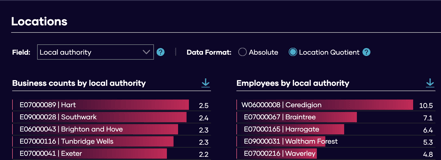Location Quotients
What are location quotients? How do I interpret them? What do I need to know about the data?
What are location quotients?
Location quotients are a measure of relative concentration of an industry in an area.They are useful for comparing areas of different sizes.
Traditional location analysis sometimes overlooks the size of the area. Location quotients account for this.
How are they calculated?
Location quotients compare the local presence of an industry with the national presence of the industry.
I.e. they measure the presence or size of the industry against what would be expected for an area of this size, based on the national average for the industry.
The formula for calculating employee based location quotients is included at the bottom of the page, as an example, to illustrate how location quotients are calculated.
Example
They help us to answer questions such as "Which industries are overrepresented in Leeds?" and “Where is industry X overrepresented?”.
Leeds is likely to have a smaller absolute count of businesses than London, but after accounting for the sizes of the geographical economies, location quotients could identify Leeds as having the greater relative concentration of businesses in a specific sector.
How do I interpret location quotients?
Location quotients are a unit-less measure.
A value of 1 means that the proportion of companies in industry X in an area is the same as the proportion found nationally. This means you are equally as likely to find industry X in an area as you would across the nation.
A value of 2 means you are twice as likely to find industry X in an area as you would across the nation.
Conversely, a value of 0.5 means you are half as likely to find industry X in an areas as you would across the nation.
Location quotients are found on ANALYSE, under the locations tab.

Above: The top 5 local authorities where Agency Market companies are overrepresented.
What should I know about the data?
The Data City provide location quotients for business count, employees and turnover. Location quotients using employees and turnover are subject to the wider caveats of our employee and turnover data.
1) Similarly, local authorities that have a very small business base are more prone to very large location quotient values. For example the Isles of Scilly has 82 businesses.
Imagine that across the UK that 5% of UK businesses are restaurants. If the Isles of Scilly had 30 restaurants, that would not be a particularly high number of restaurants in absolute terms. In relative terms this would be a large proportion of the overall business base (37%). This would indicate a strong overrepresentation of restaurants in Isles of Scilly, with a location quotient of 7.4. Some care is required in using location quotients for particularly small local authorities.
2) Location data can be subject to biases, such as the registered office effect. UK companies of all sizes often register in London despite having minimal real activity in London.
Large global companies are more likely to be registered in London than other regions. This results in oddities, such as London having large location quotients for tobacco and mining companies.
3) Additionally, multinational companies' employee counts, as reported in their annual accounts, often report all global employees. This will have an impact on location quotients.
Location quotient formula example - employees
